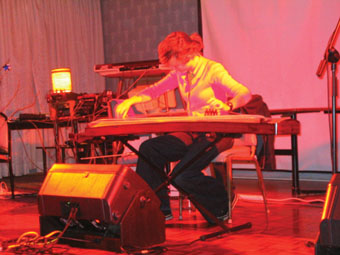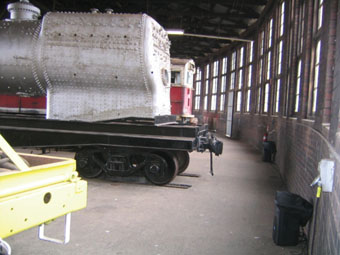Installations out of Wagga
Bruce Mowson

Clare Cooper
photo Anna Liebzeit
Clare Cooper
unsound04 featured 2 days and nights of installations and performance marked by a wonderful sense of community generated by the generosity, humour and hospitality of those involved. The evening program included performances by Team Red, Lawrence English, Clare Cooper, The Von Crapp Family, Dirt Bones Assembly, The Re-mains, Bureau Infidel, Sleepville, Garry Bradbury, Lucas Abela, spbaker, ffwuc and Oren Ambarchi.
Many of these deserve more attention than space allows, and some of the performances incorporated video components that seemed underdeveloped and unnecessary. Lucas Abela’s performance lived up to expectations, with the artist, a piece of glass and an electronic current fusing in a dynamic and sustained scream evocative of the moment of birth of Frankenstein’s monster, or a cathartic electrified cunnilingus. Oren Ambarchi’s deft improvisation was an engaging, rapidly evolving stream of sound. The Von Crapp family were fantastic: the youngest family member lashed out on a mini-drum kit while dad cut up a guitar and the eldest boy played kazoo, standing in crucifixion pose and dressed in a black KKK outfit. An apt antidote to John Howard’s ‘family’-oriented policy platform and its mule-like braying of Barbie and Ken normality. However, while the performances were satisfying it was the installation program that separated unsound from other festivals.
Mutable Landscapes, a program of 7 site-specific collaborative artworks, is the brain-child of unsound04 curator and project manager Sarah Last. On Saturday and Sunday audience members travelled on a bus to visit the installation sites scattered around the surrounding countryside. The bus ride itself became a significant experience with opportunities to talk and build anticipation for the next work. Each installation was allocated a minimum of 45 minutes of listening/viewing time, allowing for a slow process of exploration, consideration and discussion.
Melissa Delaney and Dominic Redfern worked together in the print workshop of the now abandoned University Visual Art Department. Their installation was perhaps the most considerate of local factors and existing content, a vivid and articulate multi-channel sound and video work. Melissa and Dom are interested in the reappropriation of space by nature, but I read the work as highlighting the absence of life—human or vegetable—within an apparently functional building. The sound composition was particularly memorable; a series of sound screens, discrete walls of mass temporarily thrown into life.
Oren Ambarchi and minus eleven error (Johannes Klabbers) presented an installation in an unlit old train carriage. The audience moved through and sat in the compartments which each contained a particular sound. Big waves of bass were felt as much as heard, with the connecting passageway containing a voice (Joseph Beuys) muttering “nee, nee, nee” at one end and “ja, ja, ja” at the other. The raw physicality of the bass contrasted with the simple philosophy of the speech, with the repetition of both parts making for a slightly hypnotic sense of abstraction.

Michael Graeve & Scott Howie, sound installation, Junee Railway Roundhouse
photo Anna Liebzeit
Michael Graeve & Scott Howie, sound installation, Junee Railway Roundhouse
Michael Graeve and Scott Howie’s installation, comprising edited field recordings and domestic turntables, was set in the Junee railway round-house, a circular structure with some 35 locomotives around the edge and a rotating turntable in the centre. It was from the centre of this turntable that the work was best experienced. The strongest aspect of the work was its use of the building’s scale, with sounds projected at the audience from across what felt like a great distance. The composition co-existed with the feel of the workshop itself—strong material at a quiet pace.
A third installation at the railway round-house was Parallax by Lawrence English and Adam Bell. Set in a small 2-room structure, the work featured the sound of a slow drip and a self-destructing speaker amplified by a 40 gallon drum. While the work contrasted nicely with the scale of the other installations, it didn’t provide quite the same open and evocative experience.
Gary Butler and Damien Gooley worked together in Coolamon’s historic Up-To-Date store. This space had a stand-offish, slightly foreboding feel, and it took 10 minutes to begin to take stock of what was happening. The key for me was a set of wired up Ugg Boots which emitted a series of sheep bleats. The ‘Baa’-producing electronic mechanism was located in a member of the small herd of lamb-sized blow-up sheep sex dolls hanging from the ceiling. I was thinking that Butler, who conceived this aspect of the work, had a refreshingly keen sense of humour until the site-specificity of the work was revealed. As the story goes, Coolamon, in the context of a civic meeting, had decided that it needed an angle to attract visitors, and selected the concept, “Coolamon, Home of the Dirty Weekend.”
Alan Lamb and Scott Baker worked together on an Aeolian Harp, the instrument from which Alan records his Wire Music. It was fascinating to see the mechanism of this music: literally a set of wires strung between 2 rocks across a slight valley, with a number of contact microphones amplifying the small sounds within the wires. These were further amplified through a car stereo and also broadcast on an FM transmitter. Listening to the music in headphones was a startling experience, as the sound of the world was silenced and replaced by the electronic whips and ringings of the wire. Ideally, the wires respond to variations in wind and temperature, creating their signature harmonic drone. In this case the wind blew from the ‘wrong’ direction, leading to an interesting discussion with Johannes Klabbers (Wagga Space program co-founder) about the incorporation of ‘failure’ in the works: “if you are going to work with nature, you have to go with it.” This work is installed permanently and visitors can be taken out to the site on request.
Sarah Last and Raimond DeWeerdt developed one of the most inventive sound installations I’ve ever encountered. Erected in a small clearing were 6 tents in which the artists were breeding flies with the intention on making them ‘perform’ by prodding the tent with sticks. Unfortunately, in the weeks leading up to unsound the weather was not hot enough to stimulate the breeding process. While the work failed in one sense, the concept is evocative, and it takes only a small leap to imagine the intensity and strangeness of hearing thousands of flies buzzing at close range.
Last has designed an excellent program, incorporating interesting sites, site-specific production, well documented artistic collaborations and an intelligent mode of consumption. These approaches are her response to dissatisfaction with the lack of inclusion of regional new media arts practice into metropolitan exhibitions and the shortcomings of the new media industry and its attendant professionals. The absence of institutional involvement, of overwhelming architecture, of security personnel and marketing hype, made clear how much these factors can distract and detract from an interesting art experience.
Mutable Landscapes was an intriguing, and satisfying program which challenged its artists through choice of sites and collaborators rather than through fatuous themes. There was not a whisper of “the work is beyond your grasp”, “ahead of its time” or “isn’t it amazing what can be done with technology?”, or any of the other excuses posed for the ongoing stream of tedious new media installations that lack ideas and/or the confidence to create an experience. Congratulations to all at the Wagga Space Program.
Mutable Landscapes, unsound04, curator Sarah Last; presented by the Wagga Space Program; Wagga Wagga, NSW; Nov 13-14, www.space-program.org/unsound/
RealTime issue #64 Dec-Jan 2004 pg. 10






